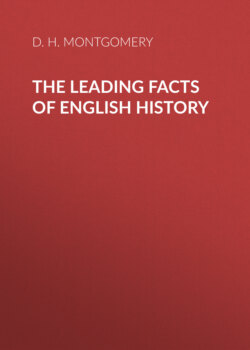The Leading Facts of English History

Реклама. ООО «ЛитРес», ИНН: 7719571260.
Оглавление
D. H. Montgomery. The Leading Facts of English History
The Leading Facts of English History
Table of Contents
FIRST PERIOD[1]
BRITAIN BEFORE WRITTEN HISTORY BEGAN
SECOND PERIOD[1]
THE GEOGRAPHY OF ENGLAND IN RELATION TO ITS HISTORY[2]
THIRD PERIOD[1]
ROMAN BRITAIN, 55 B.C.; 43–410 A.D. A CIVILIZATION WHICH DID NOT CIVILIZE
[TWO PAGES MISSING (21–22)] FOURTH PERIOD[1]
THE COMING OF THE SAXONS, OR ENGLISH 449(?) A.D. THE BATTLES OF THE TRIBES—BRITAIN BECOMES ENGLAND
EK HLEWAGASTIR - HOLTINGAR - HORNA - TAWIDO
FIFTH PERIOD[1]
THE NORMAN CONQUEST. THE KING AGAINST THE BARONS
GENERAL REFERENCE SUMMARY OF THE NORMAN PERIOD (1066–1154)
SIXTH PERIOD[1]
THE ANGEVINS, OR PLANTAGENETS, 1154–1399. THE BARONS VERSUS THE CROWN
SEVENTH PERIOD[1]
EIGHTH PERIOD[1]
Part of the money obtained from the sale of church property was devoted, mainly through Edward's influence, to the endowment of upwards of forty grammar schools, besides a number of hospitals, in different sections of the country. But for a long time the destruction of the monastic schools (SS45, 60), poor as many of them had become, was a serious blow to the education of the common people
CHARLES II—1660–1685
I WILL MAINTAIN THE LIBERTIES OF ENGLAND AND THE PROTESTANT RELIGION
ANNE—1702–1714
GENERAL REFERENCE SUMMARY OF THE STUART PERIOD
TENTH PERIOD
GEORGE IV—1820–1830
WILLIAM IV—1830–1837
VICTORIA—1837–1901
EDWARD VII—1901–1910
CONSTITUTIONAL DOCUMENTS
THE PETITION OF RIGHT
MISCELLANEOUS ACTS AND LAWS
DESCENT OF THE ENGLISH SOVEREIGNS FROM EGBERT TO GEORGE V*
SPECIAL READING REFERENCES ON TOPICS OF ENGLISH HISTORY[1]
Отрывок из книги
D. H. Montgomery
Published by Good Press, 2019
.....
So skillfully and substantially were these highways constructed, that modern engineers have been glad to adopt them as a basis for their work. The four chief Roman roads[1] continue to be the foundation, not only of numerous turnpikes in different parts of England, but also of several of the great railway lines, especially those from London to Chester and from London to York.
[1] The four chief roads were: (1) Watling Street; (2) Icknield Street; (3) Irmin Street; and (4) The Fosse Way. (See map facing p. 14.)
.....